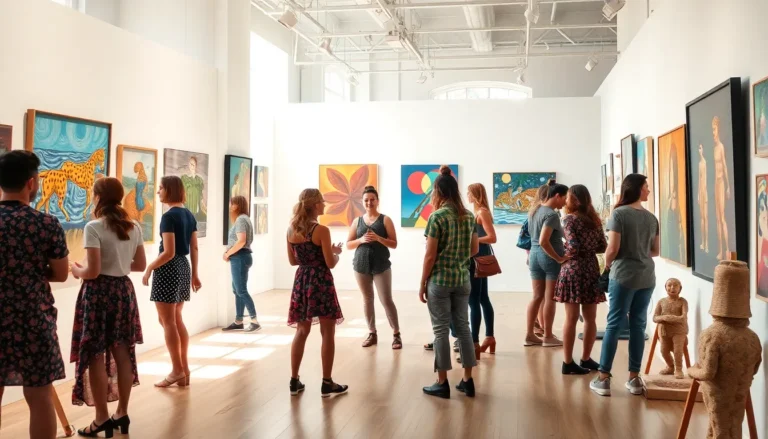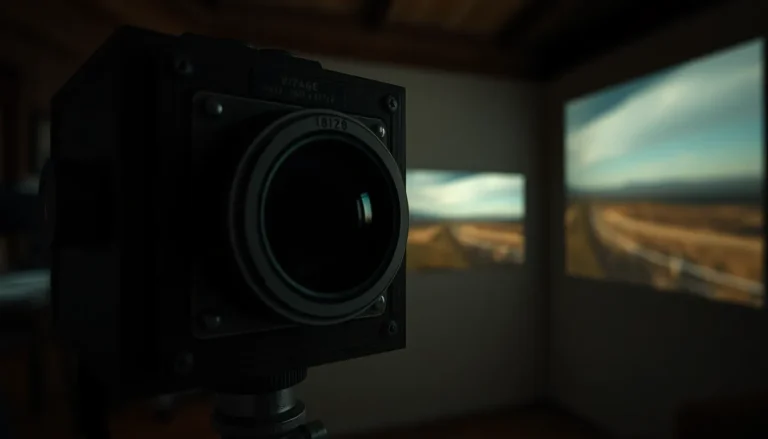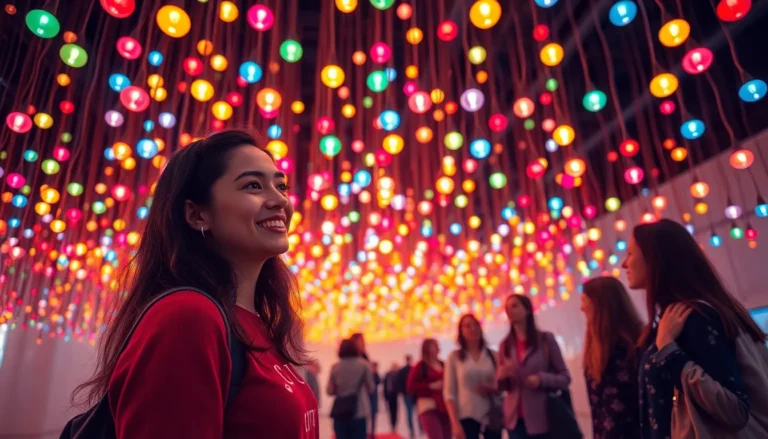Table of Contents
ToggleWhen it comes to modern art, America and Europe have danced to very different tunes. Picture this: Europe, with its rich history of classical art, is like an elegant ballet, while America bursts onto the scene like a jazz band—bold, improvisational, and a little unpredictable. This clash of cultures not only shaped the artists but also the very essence of their work.
From abstract expressionism to pop art, American artists embraced a spirit of rebellion and innovation that often left their European counterparts scratching their heads. While Europe focused on tradition and technique, America was busy breaking the rules and redefining what art could be. Join the exploration of this vibrant artistic divide, where creativity knows no bounds and the only limit is the imagination.
Overview of Modern Art
Modern art in America differed significantly from that in Europe, reflecting diverse cultural influences and artistic philosophies. American artists often pursued innovation, using their work to challenge existing norms. Movements such as Abstract Expressionism emerged, showcasing spontaneity and emotional depth that captivated audiences. In contrast, European artists typically adhered to established techniques and traditions, focusing on precision and historical themes.
American art embraced a sense of freedom and exploration. Artists like Jackson Pollock and Mark Rothko splashed paint and created immersive environments, emphasizing the act of creation itself. European contemporaries centered on meticulous craftsmanship and often incorporated classical references in their work.
Cultural context played a crucial role in shaping these artistic directions. The United States experienced rapid industrialization and urbanization, fueling a sense of restlessness that manifested in artistic experimentation. European artists, influenced by long-standing traditions, often viewed art through a critical lens grounded in history and technique.
Collaboration between different artistic movements marked the American scene. The rise of Pop Art, led by figures like Andy Warhol, blended commercialism with fine art, further diverging from European ideals. Unique to America, the fusion of art and popular culture redefined the boundaries of artistic expression.
Artistic institutions also displayed contrasts. American galleries encouraged avant-garde exhibitions, supporting rising artists without established reputations. European institutions frequently prioritized works that adhered to traditional artistic standards, shaping the environment in which artists operated.
These differences contributed to the vibrant artistic divide, highlighting how limitless creativity characterized American modern art while traditional values remained central to European expressions. The dynamic landscape of American art offered a platform for diverse voices, ultimately enriching the global art narrative.
Key Differences Between American and European Modern Art

American and European modern art exhibit significant differences rooted in their historical and cultural contexts.
Historical Context
American modern art emerged from a backdrop of rapid industrialization and urbanization. This environment fostered a restlessness that drove artists to experiment boldly. In contrast, Europe’s modern art developed from centuries of established artistic traditions and classical influences. While Europeans often focused on precision and historical themes, American artists prioritized innovation and emotional expression, reflecting the dynamic changes in their society. Movements such as Abstract Expressionism and Pop Art challenged norms and redefined artistic practices, showcasing American creativity.
Cultural Influences
Cultural influences shaped both American and European art in distinct ways. American artists drew inspiration from diverse sources, including jazz music and commercial advertising, resulting in a vibrant aesthetic. European artists, however, leaned heavily on their rich historical legacy, emphasizing traditional techniques and narratives. The fusion of different cultural elements in America led to a more improvisational approach, while Europe maintained a focus on craftsmanship and established themes. This divergence created a unique artistic landscape in each region, enriching the global art scene.
Major Movements in American Modern Art
American modern art features several distinctive movements, each reflecting its cultural landscape and innovative spirit. Movements like Abstract Expressionism and Pop Art exemplify this rich diversity.
Abstract Expressionism
Abstract Expressionism emerged in the late 1940s, representing a profound departure from traditional artistic techniques. Artists like Jackson Pollock and Mark Rothko championed spontaneity and emotion over representation. They utilized bold colors and dynamic forms, aiming to evoke visceral responses from viewers. This movement encouraged freedom in creativity, allowing artists to explore their subconscious and raw human feelings. Pollock’s drip paintings and Rothko’s color fields exemplify this ideology, emphasizing individuality and personal expression. Abstract Expressionism defined a significant moment in American art, illustrating the nation’s desire to break free from European constraints.
Pop Art
Pop Art surfaced in the 1960s as a vibrant commentary on consumer culture, mass media, and popular imagery. Artists such as Andy Warhol and Roy Lichtenstein played pivotal roles, using everyday objects and commercial techniques in their works. Warhol’s Campbell’s Soup Cans and Lichtenstein’s comic book-style paintings showcased a fusion of high art and popular culture. This movement challenged prevailing notions about what constituted art by blurring the lines between artistic expression and commercialism. Bright colors and repetition characterized the style, drawing the viewer’s attention to the omnipresence of consumer goods. Pop Art marked a transformative period, highlighting the interplay between art and contemporary society.
Major Movements in European Modern Art
European modern art featured various movements that significantly influenced the global art scene. Cubism and Surrealism emerged as two of the most impactful trends, each reshaping perceptions of art and reality.
Cubism
Cubism originated in the early 20th century, primarily shaped by Pablo Picasso and Georges Braque. This movement dismantled traditional perspectives, showcasing subjects from multiple viewpoints simultaneously. Artists utilized geometric forms and fragmented planes, shifting the focus from realistic representations to abstract interpretations. Paintings like Picasso’s “Les Demoiselles d’Avignon” exemplified the break from conventional techniques. Additionally, the use of muted colors emphasized the structural elements over emotional responses. Cubism laid the groundwork for modern abstraction, inspiring numerous artists and movements across Europe and beyond.
Surrealism
Surrealism took root in the 1920s, influenced by the ideas of psychoanalysis and dreams. Artists such as Salvador Dalí and René Magritte sought to unlock the unconscious mind, producing artworks that defied logic and embraced bizarre imagery. Surrealist works often involved unexpected juxtapositions, challenging preconceptions about reality. Dalí’s “The Persistence of Memory” vividly illustrates this approach, with melting clocks symbolizing the fluidity of time. The movement aimed to explore inner thoughts and emotions, pushing boundaries in both technique and subject matter. Surrealism sparked creativity and experimentation, resonating with audiences and inspiring future generations of artists.
Impact on Global Art Scene
American modern art radically transformed the global art scene, ushering in new perspectives and challenging established norms. The boldness of Abstract Expressionism and the satirical edge of Pop Art garnered international attention, influencing artists worldwide. These movements championed individual expression, allowing creators to explore personal narratives instead of adhering strictly to tradition.
European modern art, while revolutionary, often focused on historical themes and refined techniques. Iconic movements such as Cubism and Surrealism set the stage for creative exploration. Artists like Picasso and Dalí broke boundaries, yet their works often maintained a connection to traditional frameworks. This contrast highlighted the divergence in artistic approaches between the two regions.
Distinct cultural backgrounds fueled the evolution of art in both America and Europe. In the U.S., an emphasis on experimentation gave rise to techniques that celebrated spontaneity. European artists, however, maintained deep ties to their artistic heritage, prioritizing meticulous skill and craftsmanship. This cultural dichotomy enriched the global art narrative by showcasing a spectrum of creative influences.
Artists throughout the decades have drawn inspiration from these contrasting practices. American artists embraced pop culture, reflecting the fast-paced life of urban America. This engagement with consumerism marked a departure from the more introspective nature of European art, fostering a dialogue that resonated globally. Innovations in technique and cultural commentary paved the way for future artistic movements.
The impact of American modern art remains palpable today. It challenged artists across the globe to redefine their own artistic expressions. As such, the interplay between American and European art sets a foundation for ongoing creativity and inspiration, solidifying each region’s unique contributions to the global art landscape.
The divergence between American and European modern art illustrates a rich tapestry of creativity and innovation. American artists broke free from tradition, embracing spontaneity and cultural influences that shaped their unique expressions. Meanwhile, European artists maintained a connection to historical techniques and themes, reflecting their classical roots.
This contrast not only highlights the distinct artistic landscapes of each region but also enriches the global art narrative. As these two worlds continue to interact and inspire one another, the legacy of modern art remains a testament to the power of creativity and the endless possibilities of artistic exploration.







